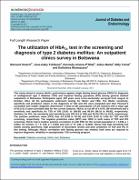| dc.contributor.author | Omech, Bernard | |
| dc.contributor.author | Tshikuka, Jose-Gaby | |
| dc.contributor.author | Amone-P’Olak, Kennedy | |
| dc.contributor.author | Mwita, Julius | |
| dc.contributor.author | Tsima, Billy | |
| dc.contributor.author | Nkomazana, Oathokwa | |
| dc.date.accessioned | 2021-11-23T07:36:36Z | |
| dc.date.available | 2021-11-23T07:36:36Z | |
| dc.date.issued | 2017 | |
| dc.identifier.citation | Omech, B., Tshikuka, J. G., Amone-P’Olak, K., Mwita, J., Tsima, B., & Nkomazana, O. (2017). The utilization of HbA1c test in the screening and diagnosis of type 2 diabetes mellitus: An outpatient clinics survey in Botswana. Journal of Diabetes and Endocrinology, 8(1), 1-8. | en_US |
| dc.identifier.uri | https://hdl.handle.net/123456789/358 | |
| dc.description.abstract | This study aimed to assess HbA1c performance against single fasting blood glucose (FBG) for diagnosis
of undiagnosed type 2 diabetes (T2D) and impaired fasting glycaemia (IFG) among general medical
outpatients in Botswana. Participants aged, ≥20 years were cross-sectionally surveyed from August to
October, 2014. All the participants underwent testing for HbA1c and FBG. The HbA1c sensitivity,
specificity and predictive values in the diagnosis of T2D and IFG were computed and their Pearson’s
correlation and scatter diagrams determined. A total of 291 participants (74.2% women) with a mean age
of 50.1±11.0 years provided data for the current analysis. HbA1c at cut-off of ≥ 6.5% (48 mmol/mol) had a
sensitivity and specificity for T2D of 100 (15.81 to 100.00) and 86.3% (86.16 to 89.92), respectively.
Similarly, for IFG, the sensitivity and specificity was 100 (2.5 to 100) and 36.3% (30.3 to 42.6), respectively.
The positive predictive value (PPV) was 4.8 (0.58 to 16.16) and 0.6% (0.02 to 3.45) for T2D and IFG
screening, respectively. The negative predictive value (NPV) was 100% in both cases of T2D and IFG
screening. HbA1c had a modest, positive correlation (r) with FBG for the overall population (r = 0.536, p <
0.001); for women, (r = 0 .578, p < 0.001) and men (r =0 .336, p =0.003). HbA1c had high sensitivity but
widely varying specificity, high proportion of discordant results and poor prediction of T2D and IFG in
this setting. Although, HbA1c correlation with fasting glucose was modest, both tests are required to
improve diagnostic reliability in asymptomatic T2D screening program. | en_US |
| dc.language.iso | en | en_US |
| dc.publisher | Journal of Diabetes and Endocrinology | en_US |
| dc.subject | Diabetes screening | en_US |
| dc.subject | HbA1c test | en_US |
| dc.subject | Botswana | en_US |
| dc.title | The utilization of HbA1c test in the screening and diagnosis of type 2 diabetes mellitus: An outpatient clinics survey in Botswana | en_US |
| dc.type | Article | en_US |

